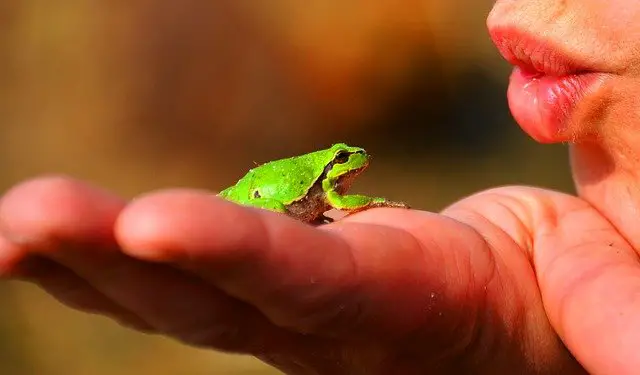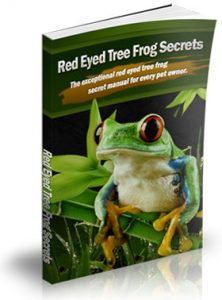Trees frogs are carnivores; this means that they eat a diet based on meats. In this wild, they would prey on insects. When kept in captivity, this means that you must supply your tree frog with various insects such as crickets and locusts to keep him healthy.
Introduction to What Do Tree Frogs Eat?
Tree frogs make great pets if you are looking for an animal that you can observe rather than give lots of affection to. They have extremely sensitive skin which can become damaged if they are handled too much. For this reason, they have not considered a terribly straightforward pet to keep.
But this is just a small part of their care. When keeping a tree frog in captivity, you must also pay close attention to what your pet needs to eat. Keeping this diet as close to what they would eat in the wild is imperative for maintaining good health.
In this article, we are going to be looking at the diet of the tree frog and how you can make sure that your pet receives a well-balanced and nutritious diet.
Tree Frog Diet
Tree frogs are popular as pets because of their beautiful coloring and their small size. They need an enclosure that is big enough for them to move around but ten gallons is usually a good starting point so they can make a great exotic pet for those with limited space.
The most common tree frog species kept as a pet is the American green tree frog and their diet consists of mainly insects. This is what they would eat in the wild and you should make sure that this diet is replicated as closely as possible as these foods contain all the nutrients that your pet needs to thrive.
For the most part, tree frogs are nocturnal creatures although they have been known to go hunting during the day when it is needed. Most tree frogs are quite small, in fact, some could quite easily sit on the tip of your finger with room to spare when they are young. Fully grown tree frogs tend to be around 11 cm. At this size insects, small invertebrates, and worms are the ideal food.
Owing to their excellent climbing abilities, tree frogs are able to hunt a vast number of different types of prey. They spend most of their time in the trees but will move down if they spot a tasty titbit. Since they are not fussy eaters, their diet may stray away from what is typical and they are known to frequently go after newly hatched birds, small lizards and snakes, and even other frogs if the size is right.
There are some slightly larger species of tree frogs that are known to prey on small mammals but these varieties are not as common as the smaller tree frogs.
Tree frogs are passive hunters and have long tongues that allow them to catch their prey without moving too much. However, this does not mean that your tree frog will never chase their prey. They are known to jump or leap towards prey if it is out of reach or being particularly tricky to catch.
When they use their long tongues, they will stick to the prey and the frog can bring it back into the mouth. While tree frogs do have teeth, these are not sufficient for chewing and so the frog typically swallows the prey whole.
Feeding A Tree Frog In Captivity
The food that you offer your pet will largely depend on the species of tree frog that you have adopted. For example, the most common type of tree frog pet, the American green tree frog will be happy with a diet of crickets, mealworms, and flies. However, other types require different food.
If you own a Pacific tree frog, her diet may be a little more complex. This species loves to eat spiders, beetles, and ants. That being said, without collecting them from the wild, which we would not recommend, these may be a little more difficult to come across. For this reason, most pet owners would still stick to offering foods that can be found in pet stores such as crickets and worms. These will provide the animal with the right nutrients and certainly won’t do her any harm.
Another thing that you should keep in mind is that tree frogs can vary in size, particularly if you have adopted one as a baby. Therefore, it is essential that you only offer foods that are suitable for the frog’s size. There is no use offering a tiny tree frog a cricket that is almost double its size.
How To Correctly Prepare Food For Your Tree Frog
One of the biggest things to think about when feeding your tree frog is how you prepare the food. Most importantly, you must make sure that any insects you offer have been gut-loaded.
Gut-loading is a feeding process that insects go through before being fed to pets. If you are breeding your own insects, you will need to do this yourself, otherwise, just check with your supplier that they have been gut-loaded.
To do this yourself, you must feed the insects on a diet that is highly nutritious. This must be done for at least 24 hours before they become your pet’s next meal. The process works with the insect storing all of this nutrition in their gut which is passed on to the frog when he eats the insect.
Foods that you can offer for gut-loading include fruits, vegetables, grains, and even tropical fish flakes. Before you give the insects to your frog, it is important that you dust them with calcium powder. This is so that the frog gets enough calcium as the crickets do not contain a sufficient amount.
Buying insects from the pet store or breeding them yourself are the best ways to feed your tree frog. As we touched on earlier, you should never collect insects from the wild to use as food. This is because these insects may have fed on plants and crops that have been sprayed with pesticides and these could be passed on to your frog. Furthermore, they may have bacteria or parasites that could be harmful to your pet’s delicate immune system.
Offering live food is the best option for tree frogs. Their natural instinct is to hunt and they are unlikely to show much of an interest in dead insects. Although they may do, they will certainly prefer a live meal.
- Crickets
- Locusts
- Mealworms
- Waxworms
- Moths
- Flies
- Beetles
Tree frogs do not need to be given any sort of plant-based foods such as vegetables, fruits or leafy greens as once they exit the tadpole stage, they are exclusively carnivorous.
Once you have your insects prepared, you can offer them to your pet. But it is also important to know how often your tree frog needs a meal.
How Often Do Tree Frogs Eat?
It can be difficult to wrap your head around when you hear that your tree frog doesn’t need to eat three meals a day as we do. Some pet owners worry that they need more, but their biology is vastly different from ours so it is important not to overfeed your pet. If you do, this could result in him becoming overweight, even obese and this can cause a whole host of health problems.
It is known that tree frogs are opportunists; if they see prey, they will take it while they can. This means that if you were to provide them with multiple meals every day, they would likely eat it. It would not take long before you noticed significant weight gain. If this does happen, you would need to cut back on the amount that your frog is eating and give him an opportunity to lose weight.
Adult tree frogs will only need to feed two or three times a week. It may not seem a lot, but this will be more than sufficient. If you notice that your tree frog seems hungry, then this can be boosted to every other day. You will likely notice that your tree frog eats more during the warmer spring and summer months than he does in the winter, but don’t let this be a cause for concern, it is normal.
At each meal, you can provide your pet with between two and four crickets.
What About Baby Tree Frogs?
If you are breeding tree frogs, you will start off with tadpoles. These are the live young of all types of frogs and for this species, they need a diet that will help them thrive and grow into healthy adults.
As they begin their life as a tadpole, the tree frog is not yet carnivorous. This means that you will need to provide them with plant-based foods. One of the best things to give to your tadpoles is lettuce. You must boil the lettuce and break it into small pieces and this will give the tadpoles all the nutrition that they need.
If you have a juvenile tree frog, his diet will differ slightly from that of a fully grown specimen. Your baby tree frog may be too small to handle the larger crickets and insects that you would typically offer an adult tree frog. For this reason, you might offer fruit flies, moths, and small cockroaches. The babies will need to be fed once a day until they are fully grown.
Do Tree Frogs Need Water?
Frogs are amphibious animals, this means that they spend part of their lives on land and part of it in the water. It would stand to reason, therefore that your tree frog needs water to survive. But what about drinking? There are some animals that do not need very much water at all but the tree frog will need water on hand at all times.
This can be offered in a shallow bowl, make sure it’s relatively large. It must be shallow since, while they are amphibious, tree frogs are not excellent swimmers. It is unlikely that you will see the frog drinking from the water bowl since these animals typically absorb water through their skin rather than drinking it as we would. That being said, it is not uncommon for tree frogs to be seen drinking water droplets from the leaves.
Since your tree frog takes most of his water by absorbing it, it is important that you spray him at least once a day with clean, fresh water to keep him moist.
Conclusion
Tree frogs make excellent pets but if you want to take one on, you must be certain to offer her a balanced and nutritious diet. In the wild, these frogs are opportunist hunters and will frequently prey on whatever they can get their tongues on. However, in the main, their diet consists of insects and worms.
When kept in captivity, you can provide your tree frog with between two and four crickets that have been gut-loaded and dusted with calcium powder, two to three times a week; a maximum of every other day.
Young tree frogs may need daily meals until they are fully grown and their diet will differ slightly and may include moths and flies. Most importantly, you should ensure that the size of the insect is not too big for your tree frog.





